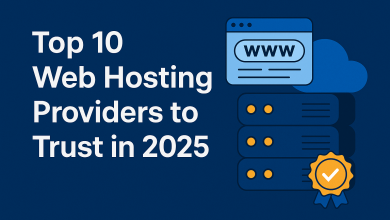🛡️ Introduction
As cyberattacks become more frequent and sophisticated, securing your website is more important than ever. Whether you’re running a blog, eCommerce site, or business portfolio, your hosting environment must be secure to protect your data, visitors, and reputation.
This hosting security checklist will guide you through the critical steps to evaluate and improve your web hosting security in 2025.
✅ 1. Choose a Secure Web Host
Start with a host that prioritizes security. Look for features like:
- 24/7 security monitoring
- DDoS protection
- Firewalls and malware scanning
- Automatic backups
- Account isolation on shared hosting
- Two-factor authentication (2FA)
Recommended Host: HawkHost – Secure, reliable, and budget-friendly.
🔐 2. Enable SSL Certificates
An SSL certificate encrypts data transferred between your site and your users.
- Protects login credentials and customer info
- Boosts SEO (Google prefers HTTPS sites)
- Shows a padlock in the browser address bar
Most hosts offer free Let’s Encrypt SSL. Make sure it’s enabled and auto-renewed.
🧱 3. Use Web Application Firewalls (WAF)
A WAF filters and blocks malicious traffic before it reaches your site. It helps prevent:
- SQL injections
- Cross-site scripting (XSS)
- Brute-force login attempts
Some hosting services offer WAFs as part of their plan, or you can use third-party tools like Cloudflare or Sucuri.
🔄 4. Keep Everything Updated
Old software is one of the biggest risks. Ensure:
- Your CMS (WordPress, Joomla, etc.) is always updated
- All themes and plugins are current
- You remove any unused or outdated software
Turn on auto-updates when possible—but test before major updates on a staging site.
🧰 5. Limit Access & Use Strong Passwords
Only give access to people who need it. For better security:
- Use strong, unique passwords
- Enable 2FA for all accounts
- Regularly review and revoke inactive users
- Don’t use “admin” as a username
📤 6. Secure File Permissions
Set proper permissions for files and directories:
- Files:
644 - Directories:
755 - Avoid making files or folders
777
This limits who can read, write, or execute files—crucial for keeping hackers out.
🧪 7. Run Regular Security Scans
Use built-in host tools or plugins to detect:
- Malware
- File changes
- Vulnerabilities
Plugins like Wordfence (WordPress) or tools like SiteLock can automate scanning.
💾 8. Set Up Regular Backups
Even the most secure sites need backups. Choose hosts that offer:
- Automated daily backups
- One-click restore options
- Offsite or cloud backup storage
Always store at least one backup offsite and test restoring it occasionally.
🌐 9. Use a CDN with Security Features
A Content Delivery Network (CDN) improves speed and offers extra security.
Top options like Cloudflare or StackPath provide:
- DDoS protection
- Bot filtering
- Web traffic analytics
A CDN can also mask your server’s IP address from attackers.
📋 10. Monitor Login Activity and Logs
Keep an eye on suspicious login attempts or sudden traffic spikes.
- Use security plugins for login alerts
- Enable activity logs for admin accounts
- Track failed login attempts and block IPs
🚧 Bonus: Security for WordPress Sites
If you’re using WordPress, take these extra precautions:
- Disable XML-RPC unless necessary
- Change your login URL from
/wp-admin - Limit login attempts
- Hide WordPress version number
Plugins like iThemes Security or Wordfence make these steps easier.
🏁 Final Thoughts
Hosting security isn’t a one-time task—it’s an ongoing responsibility. Following this checklist will help you:
- Prevent hacking attempts
- Protect sensitive data
- Boost trust and SEO rankings
- Maintain peace of mind
Start with a reliable host and layer on security features step-by-step. Your website—and your visitors—will thank you.





